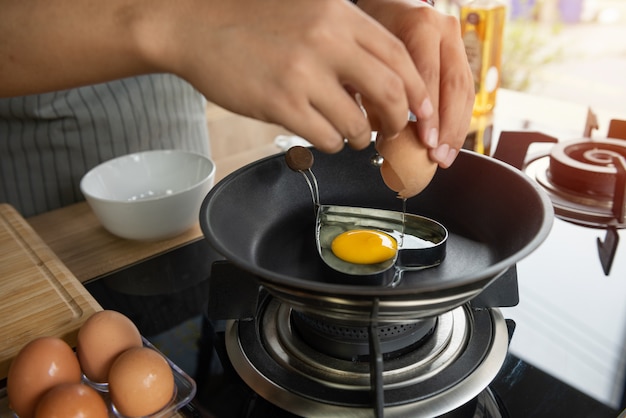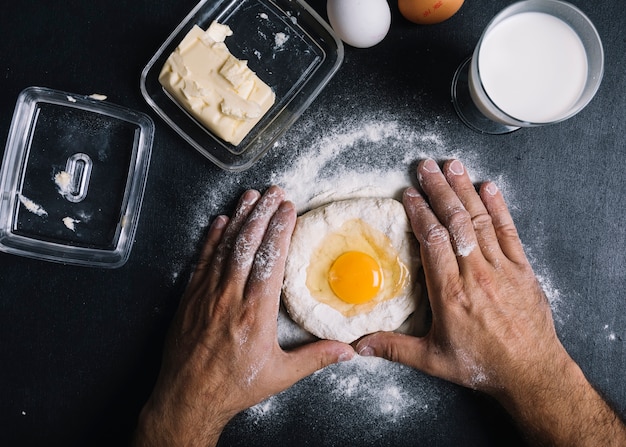Eggs, those little protein powerhouses, are a breakfast staple, a versatile ingredient in countless recipes, and a delightful snack on their own. But sometimes, you just crave a simple, straightforward boiled egg. And let me tell you, the microwave method is a game-changer. It’s quicker, easier, and produces consistently perfect eggs, no matter if you’re after a soft-boiled yolk or a firm, hard-boiled delight.
Now, I know some folks might raise an eyebrow at the idea of microwaving eggs. I used to be one of them, a staunch believer in the traditional stovetop method. But trust me, this microwave hack is a revelation. It's a revelation that's saved me countless mornings and allowed me to whip up a delicious breakfast with minimal effort. And it's a revelation I'm excited to share with you.
So, grab your microwave-safe bowl and a few eggs – we're diving into the magical world of microwave-boiled eggs. We'll explore the basics, uncover essential tips and tricks, and delve into some creative ways to enjoy these culinary gems.
(Part 1) The Basics: How to Microwave Boil an Egg

Let's start with the foundation of this culinary shortcut – the foolproof method for consistently perfect eggs. Whether you're aiming for a soft-boiled yolk that oozes with richness or a firm, hard-boiled egg for salads or sandwiches, this technique will deliver. And the best part? It's simple enough for even the most novice cook to master.
Get Your Gear
- Microwave-safe bowl: A bowl big enough to comfortably hold your eggs with at least an inch of water above them.
- Eggs: Choose eggs that are fresh and free from cracks.
- Cold water: Essential for even cooking and preventing the eggs from cracking.
- ice bath (optional): An ice bath helps stop the cooking process and makes peeling easier.
Step-by-Step Guide
- Prick the eggs: This is the secret to preventing those dreaded egg explosions. Use a pin or a needle to poke a tiny hole in the blunt end of each egg. Don't worry, the hole is barely noticeable and won't affect the flavour or texture.
- Fill the bowl: Pour enough cold water into your bowl to cover the eggs by at least an inch. This ensures even cooking and helps prevent cracking.
- Microwave: Place the bowl in the microwave and heat on high. For soft-boiled eggs, start with 1-2 minutes, and for hard-boiled, aim for 3-4 minutes. The exact cooking time will depend on the wattage of your microwave and the size of your eggs. It's always best to start with a shorter time and add more if needed.
- Chill (optional): Immediately after cooking, transfer the eggs to an ice bath to stop the cooking process. This makes peeling easier and prevents the yolk from overcooking.
- Peel and enjoy: Once the eggs are cool enough to handle, gently tap the shells to create a crack and peel them.
(Part 2) Tips and Tricks: Elevating Your Microwave Egg Game

Now that you’ve grasped the fundamentals, let’s sprinkle in some tips and tricks that'll transform you into a microwave-boiled egg wizard. These are the little refinements that make all the difference, ensuring your eggs are perfectly cooked and effortlessly peeled.
Preventing Cracks: A Little TLC for Your Eggs
No one likes a cracked egg, especially when you're trying to achieve a flawless boiled egg. These tips will help keep your eggs intact and ensure a smooth peeling experience.
- Room temperature eggs: Cold eggs are more prone to cracking in the microwave. Let them sit at room temperature for about 30 minutes before cooking.
- Don’t overcrowd: Give your eggs some breathing room in the bowl. Overcrowding can lead to uneven cooking and cracked shells.
- Cover the bowl (optional): Some swear by covering the bowl with a plate to speed up cooking. While I find it's not strictly necessary, it can be a useful technique, especially for larger batches of eggs.
Achieving the perfect soft-boiled egg: A runny yolk Dream
This is where the real magic happens, folks. The secret to a perfectly soft-boiled egg lies in that dreamy, runny yolk. It's all about finding that sweet spot between a firm white and a delicately runny center.
- Start with a shorter time: Always remember, you can add more time, but you can't undo overcooked eggs. Aim for 1 minute and check the yolk.
- Don’t overcook: The yolk should be soft and runny, with just a slight jiggle. You don’t want it to solidify completely.
- Embrace the runny yolk: This is the beauty of a soft-boiled egg. It's a perfect texture for dipping soldiers or spreading on toast, adding a touch of luxurious decadence to your breakfast.
(Part 3) Beyond the Basics: Exploring Different Microwave Techniques

So you’ve mastered the standard method, but what if you’re craving a more nuanced texture? Let's explore some alternative techniques that will take your microwave-boiled egg game to the next level.
The Speedy Single-Egg Method
For those mornings when you just need one egg, this is a lifesaver. It's super fast, efficient, and perfect for a quick breakfast or snack.
- Prick the egg: Never skip this crucial step!
- Microwave for 30-45 seconds: A soft-boiled egg will typically take around 30 seconds, while a hard-boiled egg might need an extra 15 seconds. Adjust the time based on your preference.
- Chill (optional): An ice bath isn't essential for a single egg, but it can help cool it down faster.
The steaming technique: For Extra Tenderness
If you're searching for an egg with an exceptional level of tenderness, try the steaming method. It takes a little more effort, but the result is a silky, delicate yolk that melts in your mouth.
- Prick the eggs: Always remember this essential step.
- Fill the bowl: Add about an inch of water to the bottom of your bowl.
- Place the eggs in a ramekin: Use a small, microwave-safe ramekin to hold the eggs. This prevents them from directly touching the water.
- Microwave: Cover the bowl with a plate and microwave for 2-3 minutes for soft-boiled eggs, and 4-5 minutes for hard-boiled eggs.
- Chill (optional): An ice bath is recommended after steaming to ensure the eggs are properly cooked.
(Part 4) The Great Debate: Microwave vs. Stovetop
Ah, the age-old question: microwave or stovetop? Both have their loyal followers, and each method has its merits. Let's weigh the pros and cons to see which one reigns supreme in your kitchen.
Microwave Benefits: Speed and Efficiency
- Faster cooking time: Let's face it, who has time to stand by the stove for 10 minutes? The microwave method saves you precious time, making it ideal for busy mornings or quick lunches.
- Less mess: No messy pots or spills. Just a clean bowl and a few minutes of your time.
- No need to monitor: You can set the timer and go about your day. No need to watch the pot and worry about overcooking.
Stovetop Benefits: Traditional Charm and Flexibility
- Control over cooking: You have more control over the heat and the cooking process, which can be helpful for achieving specific textures, particularly if you're aiming for a very soft yolk.
- More versatility: While you can boil eggs in the microwave, the stovetop offers a wider range of options, including poaching, frying, and scrambling.
- Nostalgia factor: There's something comforting and nostalgic about the classic ritual of boiling eggs on the stovetop.
The Verdict: It Depends on Your Preferences
Ultimately, the best method for boiling eggs comes down to your individual needs and preferences. If you value speed and efficiency, the microwave is your champion. If you prefer traditional methods and enjoy having more control, the stovetop is a great choice. There's no right or wrong answer, so experiment and find what works best for you.
(Part 5) The Art of Peeling: Mastering the Smooth Peel
Let's face it, no one likes wrestling with a stubborn egg shell. But with a few simple tricks, you can peel your eggs like a pro, leaving those frustrating bits of shell behind.
Tips for Easy Peeling
These tips will help you conquer those stubborn shells and ensure a smooth, effortless peeling experience.
- Cold water bath: This is absolutely crucial for easy peeling. The cold water helps to shrink the egg white, making the shell come off more easily.
- Tap the egg: Gently tap the blunt end of the egg on a hard surface to create a small crack in the shell.
- Roll the egg: Roll the egg between your hands to help loosen the shell from the egg white.
- Start at the top: Peel the shell away from the top of the egg, working your way down.
- Use your fingers: Instead of a knife, use your fingers to peel the shell. This helps prevent you from tearing the egg white.
(Part 6) Exploring the Wonders of Different egg textures
Let’s talk about the diverse textures you can achieve with microwave-boiled eggs. It's not just about hard-boiled or soft-boiled; there's a whole spectrum of textures to explore!
The Soft-Boiled Egg: A Runny Yolk Delight
This is the epitome of comfort food. The perfect soft-boiled egg boasts a firm egg white and a runny, oozy yolk, perfect for dipping soldiers or spreading on toast.
- Ideal for: Breakfast, brunch, snacks, and even desserts (think egg custard!).
- Pro tip: Use a spoon to carefully scoop out the yolk and drizzle it over toast or vegetables.
The Hard-Boiled Egg: A Versatile Staple
The hard-boiled egg is a true classic, perfect for salads, sandwiches, snacks, and even deviled eggs.
- Ideal for: Salads, sandwiches, snacks, and deviled eggs.
- Pro tip: For a smoother texture, add a teaspoon of vinegar to the boiling water. This helps to prevent the egg whites from spreading out.
The Medium-Boiled Egg: A Happy Medium
This is the perfect balance between soft-boiled and hard-boiled, with a slightly firm yolk and a tender white.
- Ideal for: Salads, sandwiches, and snacks where you want a firmer texture but not a completely solid yolk.
- Pro tip: Start with a shorter cooking time and add more as needed to achieve your desired texture.
(Part 7) Beyond the Ordinary: Creative Uses for Microwave-Boiled Eggs
So, you've mastered the art of boiling eggs in the microwave. Now, let’s unleash your creativity and explore some unique and delicious ways to use these perfectly cooked gems.
egg salad: A Classic with a Twist
Who doesn't love a good egg salad? This is a simple yet versatile recipe that can be enjoyed on sandwiches, crackers, or even as a dip.
- Ingredients: Hard-boiled eggs, mayonnaise, Dijon mustard, celery, onion, salt, and pepper.
- Pro tip: Add a pinch of paprika or chopped chives for extra flavour and colour.
Deviled Eggs: A Party Favourite
Deviled eggs are a classic party appetizer that's surprisingly easy to make. The creamy, tangy filling is a crowd-pleaser.
- Ingredients: Hard-boiled eggs, mayonnaise, mustard, paprika, salt, and pepper.
- Pro tip: For a richer flavour, add a dollop of sour cream or Greek yoghurt to the filling.
Egg Drop Soup: A Light and Comforting Option
This classic Chinese soup is both light and comforting. The delicate egg strands add a beautiful texture and flavour to the broth.
- Ingredients: chicken broth, soy sauce, eggs, ginger, scallions, and your favourite vegetables.
- Pro tip: For a richer flavour, use a combination of chicken and vegetable broth.
Scotch Eggs: A Savoury Delight
Scotch eggs, a British classic, consist of a hard-boiled egg wrapped in sausage meat and coated in breadcrumbs. It's a satisfying dish, perfect for a picnic or a light lunch.
- Ingredients: Hard-boiled eggs, sausage meat, breadcrumbs, and your favourite seasonings.
- Pro tip: Fry the scotch eggs in a deep fryer or a pan filled with hot oil until golden brown and crispy.
(Part 8) FAQs: Your Microwave Egg Questions Answered
Now, let's address some common questions about microwave-boiled eggs. I’m sure you have some burning questions about this method, so let’s get them answered.
1. How long do I microwave an egg for a soft-boiled yolk?
The cooking time for a soft-boiled yolk will vary depending on the wattage of your microwave and the size of the eggs. However, a good starting point is 1-2 minutes. Always check the yolk after 1 minute and add more time as needed.
2. Can I microwave boil more than one egg at a time?
Absolutely! You can microwave boil multiple eggs at once, but make sure they have enough space in the bowl to cook evenly. Don’t overcrowd the bowl, or your eggs might not cook properly.
3. What happens if I don’t prick the eggs?
If you don’t prick the eggs before microwaving, they can explode! The pressure builds up inside the egg, and the shell can crack or even burst. It’s not a pretty sight. Always prick those eggs, folks.
4. How do I know if an egg is cooked through?
The easiest way to check is to cut the egg in half. For a hard-boiled egg, the yolk should be firm and solid. For a soft-boiled egg, the yolk should be runny and oozy, with just a slight jiggle.
5. What are some other creative ways to use microwave-boiled eggs?
The possibilities are endless! Try them in salads, sandwiches, omelettes, frittatas, or even use them as a topping for avocado toast. Get creative and experiment with different flavours and textures.
Everyone is watching

Corn on the Cob: The Ultimate Guide to Perfectly Cooked Ears
Healthy MealsAh, corn on the cob. Just the name evokes images of sunny days, barbecues, and that sweet, juicy flavour that ...

Perfect Pork Roast Oven Cooking Time: A Guide to Delicious Results
Healthy MealsThere's something truly satisfying about a perfectly roasted pork. The aroma alone is enough to make your mout...

Scallops: The Ultimate Guide to Perfect Cooking
Healthy MealsAh, scallops. Those delicate, sweet, and utterly delicious morsels of the sea. They hold a special place in my...

Ham Cooking Time: How Long to Bake, Smoke, or Boil a Delicious Ham
Healthy MealsAh, ham. It's a classic, isn't it? A real crowd-pleaser, especially around holidays. And when done right, it'...

Spaghetti Squash: The Ultimate Guide to Cooking and Serving
Healthy MealsRemember that time you saw spaghetti squash at the supermarket, looking all bumpy and strange, and thought, "W...
